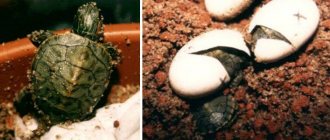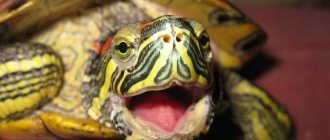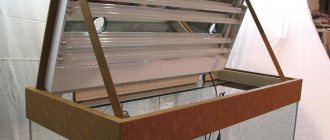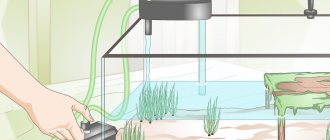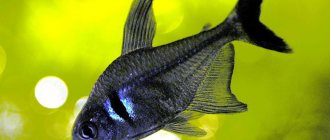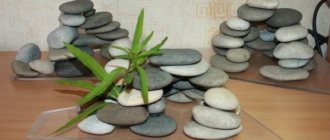If you have already purchased a glass aquarium, selected fish of certain species and plants, added decorative elements, but something is still missing to complete the picture. To add expressiveness and completeness to a small aquatic world, use an aquarium background. It is better to think in advance about the arrangement of the “water world” and select an aquarium background even before launching and populating the living creatures.
Why do you need a background?
The background for the aquarium will hide the unsightly wall, all kinds of wires and pieces of equipment from view. The background will create the impression of deeper space in the body of water. It will remove the reflections of light, give it a natural look, the fish will feel more comfortable, almost like in their natural environment. This is especially true for home ponds that are not located near the wall.
The background for the aquarium is a beautiful decorative element, which is also inexpensive and available in almost every pet store. This simple element can transform a piece of the aquatic world, especially if it is chosen correctly and looks harmonious with the rest of the aquarium environment. The background serves a decorative function.
Purpose of the background and methods of attaching it
The aquarium is for decorative purposes. The background will help not only improve the overall impression, but also hide the wall, wires and equipment behind an artificial pond. The pattern in the background makes the space look deeper. The background allows you to reduce the amount of light glare on the water and gives the fish house a more natural look. If you choose the right image, the inhabitants of the aquarium will feel much more comfortable.
Aquarium backdrops are fairly affordable and are available at most pet stores. The film allows you to quickly and easily improve or simply change the appearance of the container. The use of such decor is especially important in cases where the aquarium is not close to the wall. This arrangement usually causes discomfort in fish.
Moreover, when observing an aquarium, a translucent room distracts attention too much.
Typically, the internal background is represented by three-dimensional polyurethane foam panels. Various natural textures are used, such as stone or wood. It is necessary to clean such backgrounds, but this process is quite labor-intensive. It is worth considering that this design slightly conceals the volume of the aquarium, like any interior decor.
External background is more common due to its accessibility. There are fewer requirements for the material because it does not come into contact with water and aquarium inhabitants. For fixation, use different adhesives or just tape. The advantage is that such a background is not spoiled by growing algae. Films are sold in a very wide range and can be either plain, multi-colored or with patterns.
Modern backgrounds for external sticking can have a 3D effect. The only drawback of the film is that it is difficult to replace. If adhesive-based decor is used, it will be quite difficult to remove it. It’s better to think carefully about the desired result before decorating the back wall.
What types of background are there?
The most common types of back wall decoration are film and relief.
Film
The most convenient option for beginner aquarists, it has a number of advantages:
- The cheapest decor option.
- Wide variety of pictures. If you don’t find a suitable image in the store, you can print the one you like from the Internet.
- Easy installation and quick replacement.
- Suitable for small aquariums.
The main subtlety in using such a backdrop is to carefully stick the film onto the aquarium so that everything is smooth, without wrinkles, bubbles and protruding corners. A film backdrop is not suitable for large aquariums, where it will look unsightly. Moreover, gluing film to a large aquarium is much more difficult.
Raised
Embossed backgrounds are visually more attractive and are usually attached to the back wall of the aquarium. A volumetric background for an aquarium looks more impressive. However, it has a number of disadvantages, or better yet, features:
- Not suitable for non-standard aquarium sizes.
- It is necessary to regularly clean the algae that grows on it.
- Quite a high cost.
- Difficult to replace.
- Slightly reduces the amount of usable space.
The relief background is attached to the back wall of the aquarium from the inside using special silicone glue, which is included in the kit. This backdrop can also be secured by pressing it with soil. The first method is preferable because it is more reliable.
Direct gluing
Direct gluing can be used if design changes are not expected. Getting rid of the pasted film is problematic and will require a lot of time, so you must first evaluate whether it is worth making a permanent design.
It is also allowed to paste the background from inside the aquarium. The film is made from materials that are safe for its inhabitants and does not affect the quality of water. The only limitation for gluing the background internally is the use of methylene blue in the aquarium, which will color it.
The background film is glued to a surface that has been previously cleaned and wiped dry. Gluing is done in the same way as when using a base board. The only difference is that the excess decor is cut off and not wrapped around the base. It is convenient to trim off the remaining background with a cutter. Additionally, after smoothing the film with a soft cloth, the aquarium is left without water for 2 days so that the glue adheres tightly to the glass. When filling a reservoir, you should not pour water over the wall with the background.
If the film needs to be removed, it will be very difficult to do so, as it leaves traces of glue on the glass. It is impossible to wipe them off with a sponge. To remove glue residue, use tape, which is glued to the stain and peeled off after 2 minutes. The tape will take any remaining glue with it. The procedure is troublesome and lengthy. This is taken into account when gluing the background to the glass.
How to paste a background into an aquarium
Before sticking the background onto the aquarium, you need to thoroughly clean the glass. If specks and dust remain on the surface of the glass, they will interfere with fixation and will be visible when the backlight is on. There are several ways to glue film to an aquarium:
- Use water. The easiest way is to wet the surface of the glass with water and carefully smooth the film with a cloth or ruler.
- Glue it on tape. You can use both single-sided and double-sided tape.
- Glue on glycerin or mineral oil. This and the previous method will not work if you decide to glue the background pattern to the inside of the glass vessel.
- Use clear sealant or silicone adhesive.
Regardless of the method you choose, you will need to be careful so that the picture is not distorted and the background looks natural. To make installing the backdrop even easier, you can use aquarium stickers.
If you decide to glue the selected background to the inside of the aquarium, make sure that the glue is safe for fish.
Secrets of getting the job done
First of all, pay attention to the dust. Because of this, bubbles can form on the film, which can be noticeable and spoil the entire appearance of the aquarium. A big disadvantage will be the shadow from this dust when the backlight is turned on. Therefore, it is necessary to take care of the cleanliness of the back wall. Before gluing the film, you need to thoroughly spray water around the work area so that dust does not fly around you.
A soap solution and a spray bottle will be an assistant in cleaning glass. Spray the soap solution onto the glass and wash the surface thoroughly. Some aquarists manage to glue the film onto a soap solution, but it is almost impossible to achieve a thorough fit and no streaks.
Thus, sticking the film on the aquarium will not be difficult. It is easy to manipulate, so you can glue one today and another tomorrow, changing the interior of the aquarium at your discretion.
How to make a background with your own hands
There are several more extravagant ways to decorate your home pond. You can make the background for the aquarium yourself. For example, you can create a background for your aquarium yourself using painting. It will look picturesque if you paint the back wall of a glass vessel with stained glass paints and create an original interior landscape. The uniqueness of the background is guaranteed. This method is suitable for creative people with artistic taste.
Those who like to grow indoor plants can create a background of bindweed, tradescantia or other vigorously growing flowers and vines. Volumetric back walls made of polystyrene foam or polyurethane foam and imitating stone ledges look very impressive. The result is three-dimensional structures that are in no way inferior to the polyurethane assortment from the store.
Here you need to pay attention to dyes; choose those that are non-toxic and do not affect aquatic life. To create a suitable interior and a more comfortable environment for fish, use driftwood that will act as a shelter. In addition, they give an interesting, and most importantly, natural look to the created aquatic biotope.
Step by step instructions
To properly glue the aquarium background, you need to follow the step-by-step guide. This will allow you to decorate the structure in an even layer without bubbles or folds.
Film preparation
Before cutting the film, you should evaluate the size of the glass and cut the required piece. It is important to be especially careful at this stage, as an uneven cut will impair subsequent gluing. Cutting should be done using a utility knife and ruler. If you have no experience in performing such actions, you should practice on a small piece of film.
How to prepare glass for gluing film
The surface of the aquarium needs to be thoroughly cleaned before applying the film. If there are tiny contaminants on the glass, you will not be able to remove them after applying the layer.
It is better to clean glass with a special liquid and wipe it with microfiber.
Humidification of aquarium glass
To apply the material, you must first moisten the surface of the aquarium glass using a simple solution consisting of water and detergent (for example Fairy).
Such impregnation will facilitate the correct selection of a suitable position for the film and will quickly displace any air bubbles present.
Smoothing the film
The next step is to smooth the film to remove wrinkles and air bubbles. For these tasks, use a plastic card or ruler. It is better to move the bubbles from the central part of the film to the edges.
When applying the film, it is important to follow all stages sequentially and work carefully.
Trimming excess
At the finishing stage, you should check for traces of air or other defects on the decorative coating. The remainder of the film must be trimmed with a stationery knife.
